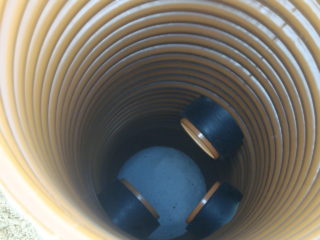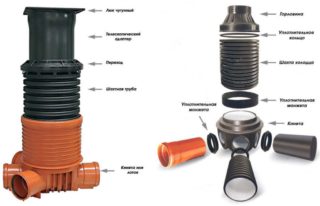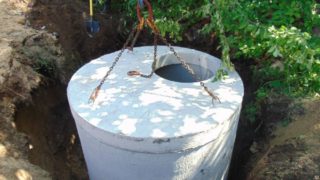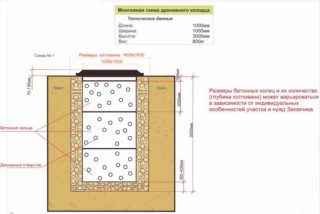Drainage wells are part of the sewerage network of the same name, which is necessary to drain excess underground moisture. Uncontrolled subsurface sources erode the foundation and reduce the yield of the soil. Devices differ in function, this must be taken into account during installation.
The purpose of the drainage well

Excessive moisture in the ground causes low yields, death of horticultural crops and destruction of building foundations. If the groundwater on the site is high, or the area is famous for an abundance of precipitation, it will be necessary to install a drainage system with the obligatory arrangement of wells.
Sometimes storm sewers are confused with drainage, but they are different. The purpose of the first is to drain sedimentary water from the surface. Drainage removes moisture from the depths of the earth, so the drains are laid below the foundation level and sent to a collection well.
Additionally, well tanks help to clean pipes from silt sediments and other sediments. When liquid enters the well, impurities settle at its bottom. The area for sedimentation must be at least 400 mm below the level of the drain connection.
Types and device

Accumulation (collector) wells are located in the lowest places of the drainage system and serve as the end points of sewer branches. They are mandatory if the possibility of quickly draining excess moisture into a ditch or body of water is not provided.
When installing a drainage system on the site, it is not enough to equip only a sump for accumulating wastewater. Other well devices will also be required. They are:
- rotary;
- inspection or revision;
- absorbent.
Rotary devices are equipped for cleaning and servicing pumping units. Wells are placed at every second turn of the storm drain. Variety - drop structures, erected on terrain with different heights of relief.
The arrangement of an inspection well is required to check the functioning of the network. They are placed on the upper points of the sewer main. Observation structures are of various sizes. For teleinspection, a structure with a diameter of 300 mm is quite enough, but if a full inspection is planned, it is necessary that a person can freely descend into the well. Revisions can also perform the functions of a rotary device.
Absorption plants are erected in the wettest places. The bottom is absent, the water is purified due to the gravel-crushed stone cushion, which is covered with filtration material. The recommended section of the well is 575 or 695 mm, and if a person needs to get there, the diameter is needed at least 900 mm.
The maximum distance between the wells is 50 meters. They must be installed in the sections of turns, changes in angles and the union of two or more drainage branches.
Inspection and absorption installations are usually mounted vertically, storage ones are also performed horizontally.
Collector wells are equipped with a submersible pump. The capacity of the pumping unit is from 100 liters per minute, its cost is from 5000 rubles. Pumps with higher power are chosen for industrial facilities or collectors.The pumping system is not required if the drainage installation is made at a slope, which ensures the drainage of water by gravity into a nearby beam or pond.
Manufacturing material and price

Drainage wells are made of reinforced concrete rings, plastic pipes or barrels, bricked.
In a small, not waterlogged area, the structure can be erected from old car tires. But it will not be as high quality as options from other materials.
Concrete and brick wells are durable, but they need to be coated with special compounds to seal them. For the installation of reinforced concrete rings, you will definitely need special equipment - they are heavy.
The most favorable ratio of price and quality for polymer structures.
Drainage wells can be purchased ready-made, with technological holes for groundwater drainage, a neck, adapters, sealing elements and a hatch with a cover. For strength, such structures are corrugated - this allows them to withstand high soil pressure. The absorbent devices are covered with perforations.
According to the shape, plastic products are:
- conical;
- cylindrical;
- rectangular.
Due to their low weight, they can be installed manually. The easiest way is to mount conical wells - the walls of the pit at an angle crumble less.
You don't have to buy a ready-made well, but make it yourself from double-walled corrugated or twisted pipes. The question is how appropriate it is.
The cost of polymer structures is low. For example, prices for narrow viewing drainage wells of the TeraPlast company start at 1,600 rubles. A ready-made revision structure with a hatch and a welded bottom, wide enough for a person to easily descend into it, will cost 11,000 rubles. For comparison, an order for the construction of a well from reinforced concrete rings will result in an amount of at least 15,000 rubles.
Installation rules
The cross-section of the pipe sections and the outlet well holes must match. The standard range of diameters is from 50 to 200 mm.
Rotating devices are installed at the break points of the network, and revision devices at the connecting nodes. The sewage main ends with the place where all the pipes converge - a filtering or storage well, from which a forced or natural drainage of moisture is carried out.
Depending on the type of well and the selected material, the installation technology is determined.
Storage or inspection well made of plastic
A corrugated pipe or a sealed container of suitable dimensions is suitable as a material for installation.
Step-by-step instructions for making the device:
- Dig a pit in size slightly wider than the container.
- Measure the required length of the corrugated pipe, then cut it off.
- With the help of bitumen, a plastic bottom is fixed on the pipe section.
- A sand cushion is poured into the pit, or a solid concrete base is prepared.
- The collected container is placed at the bottom. The pipe bends can be cut out after the tank is installed.
- They make a connection to the pipeline well and seal the cracks.
- The gaps between the well and foundation pit walls are covered with gravel, sand or a cement-sand mixture.
Self-assembly of the revision device is carried out in the same way, except for the installation of pumping equipment.
Filtration plastic well
An absorption unit will require a plastic reservoir without a bottom or pipe. You can choose perforated products or saw the holes in the lower part yourself. Installation is carried out by a method similar to that of a storage device, but without pouring a concrete base. Instead, a filter system is installed at the bottom of the well.
A cushion made of gravel, crushed stone or similar material with a thickness of 0.2–0.3 m is poured into the pit, covered with geotextiles. A pipeline is connected through the top of the well, the installation is covered from all sides with crushed stone or gravel.
Concrete ring well
Installations of any type are created from this material, but if an absorption option is assumed, the bottom or concrete screed does not need to be done. A filtration layer is required according to the scheme described above.
Installation steps:
- Dig a pit of the required size.
- A sand and gravel pillow is poured into the bottom of the pit. If a filtration chamber is installed, the layer thickness should not be less than half a meter.
- The first ring is placed on the pillow. When choosing elements without a bottom, a concrete screed is made.
- The remaining rings are laid, the seams are sealed with a concrete solution or bitumen.
- Holes are made in the last ring, pipes are inserted into them, after which all cracks are thoroughly sealed.
- From above, the well is covered with a hatch with a plastic or metal cover, since concrete products have a large mass.
- Sand, gravel or crushed stone are poured into the voids between the walls of the pit and reinforced concrete rings.
Reinforced rings with a lock are ideal for the construction of wells. In their absence, ordinary concrete products are also used. The thicker they are, the longer they will last.
The uninterrupted operation of drainage in the autumn and spring periods is facilitated by regular cleaning of wells from sludge deposits using a stick length, an irrigation hose. The installation of a tight cover on the device hatch helps to reduce contamination.









